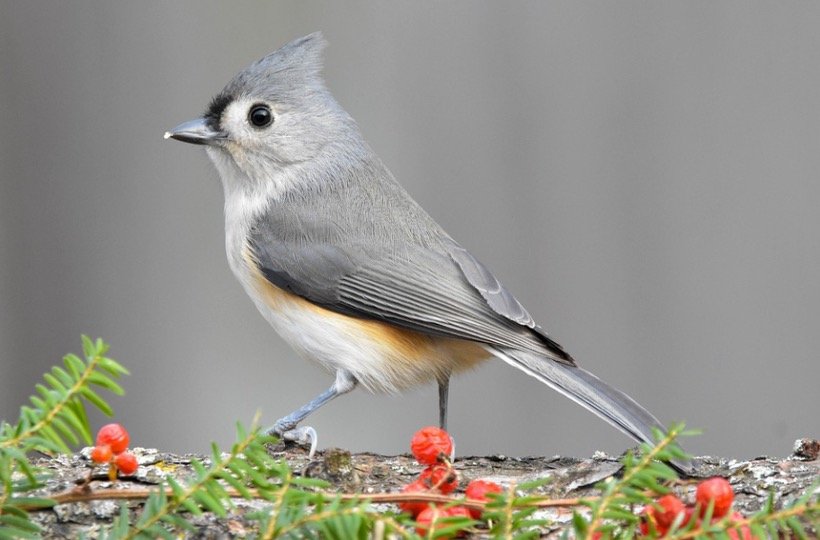Titmouse Classification
Kingdom: Animalia
Phylum: Chordata
Class: Aves
Order: Passeriformes
Family: Paridae
Genus: Baeolophus
Species: B. bicolor, B. atricristatus

Titmouse Description
Two distinct species of birds of the genus Baeolophus are referred to as the titmouse. These small songbirds are native to North America.
The titmouse belongs to the family Paridae, which also comprises chickadees and tits. The B. atricristatus is once thought of as a subspecies of B. bicolor, while now they are considered as separate species.
The color of titmouse is mostly grey with a rust-colored outline and white front, black forehead. A tufted grey Mohawk-like crest is also present in their head which is a characteristic feature of these birds.
The length of a titmouse is approximately 6 inches and the weight is only 21 grams or less than half a pound.
The preferred habitat of titmouse includes woodlands and deciduous forests. They also live in gardens and parks, where humans have disrupted their natural habitat.
They move to the ground to feed but spend most of the time in trees to avoid predation. They are omnivorous and feed on various insects such as caterpillars and wasps and other food items such as berries, nuts, and seeds. They gather food items in the tree and they are also regular visitors to bird feeders.
Titmouse Nesting and Reproduction
The female titmice make their nests in the holes and cavities in trees and sometimes also use the nest boxes made by humans. However, they cannot excavate the tree cavities and use old woodpecker nests when they cannot find a suitable nesting site.
The nest is prepared by both males and females and made with soft materials such as hair or fur from animals including pets. The shade snakeskin is also used by titmice, which may act as a predator deterrent.
About 5-7 small eggs are laid by females, which are about 1 inch long. The eggs are white or cream-colored that contain purple or brown spots. Interestingly, the fledglings of titmice that recently left the nest often help the parents to raise the young reproduce next year.
Some predators like snakes, raccoons, and skunks eat the eggs of titmice and also invade their nests. But the domestic cat is the primary predator of these songbirds. Hawk and Falcon are the major predators of adult titmice.
The lifespan of these birds is about 2.1 years in the wild but they can live more than 10 years if possible. The growth rate of the tufted titmouse population is 1.5% per year since 1960.
During this time, they have proliferated in most of the USA in human-developed areas. Their population is enough strong and they are listed as “least concern” by the IUCN.
Fun Facts About Titmouse
The tufted crest is the characteristic feature of this songbird with its charismatic and energetic behavior. But many other facts make them memorable.
i. Song
Due to their melodies voice, they are called songbirds. They tend to whistle from their perches with their vibrant and diverse song that may vary in about 20 different ways. Typical titmouse sings a repetitive or chant-like song of peter-peter-peter or here-here-here at lower pitches.
They sing a quickly whistled song of frequencies of about one to up to 35 songs per minute. Their songs play a role in communication and courting thus they sing most commonly during the breeding season.
As the neighboring titmice hear the song, it replies with the same song it indicates that they may learn or share songs in this way. At a young age, the juvenile titmice learn a song from their family and also take up the songs of their neighbors in their territory.
ii. A Homebody
Titmice are not migratory unlike most other songbirds, which migrate from the north in the summer to the south. However, the species are widespread and from their native Mississippi and Ohio, they moved across the United States and parts of Canada but the individual birds are non-migratory.
They do not relocate to avoid foul weather, instead, they live in areas that do not experience extreme conditions. Thus, they do not require migration to avoid cold.
iii. Killer Cats
Domestic cats are one of the biggest threats to songbirds including titmouse in the natural world. Cats kill approximately 1-4 billion songbirds per year in only the United States alone. Thus, domestic cats are the leading cause of mortality for songbirds, another cause is habitat destruction by humans.
Titmouse Citations
Grubb, Jr., T. C. and V. V. Pravasudov. 1994. Tufted Titmouse (Baeolophus bicolor), The Birds of North America (A. Poole and F. Gill, eds.). The Academy of Natural Sciences, Philadelphia, PA, and The American Ornithologists’ Union, Washington, D.C.
Tufted Titmouse, Baeolophus bicolor
Tufted Titmouse Identification
Share












